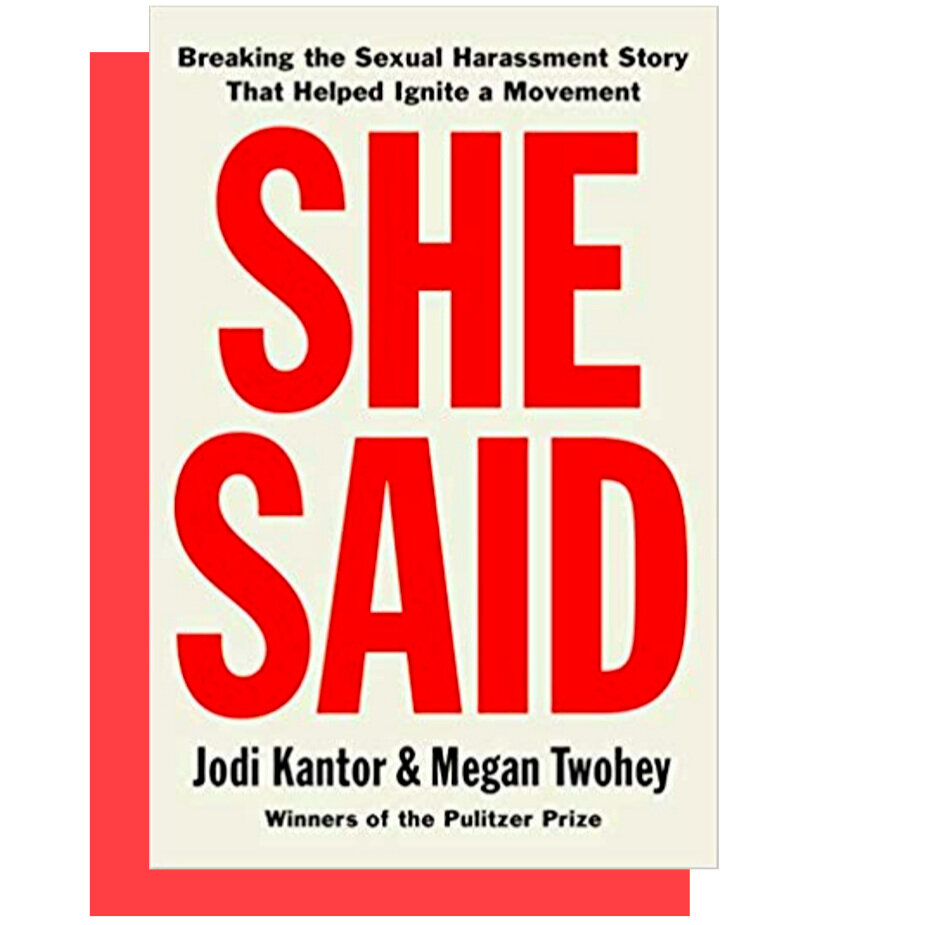When I started writing about Harvey Weinstein I genuinely intended to watch all the films he’d worked on including those for which he had only received “Special thanks.” That was going to be the title: With Special Thanks To: Producing a Culture of Impunity. At the time it seemed like I would also need access to Miramax and Weinstein Company documents, so I could prove more definitively how his predation shaped his filmmaking and promotion. To do that, I’d have to be an investigative journalist. Which I’m not.
Luckily other people are actually investigative journalists because Jodi Kantor and Megan Twohey did that work when they broke the Harvey Weinstein story in 2017, and She Said is their memoir of the experience. There are other journalism memoirs that tell the story of a story more lyrically (Susan Orlean’s The Orchid Thief s a great one!), but She Said is such a satisfying portrayal of the research process that I read it in a day. I was reading it at red lights.
She Said is more procedural, but compelling because they are piecing together information that will satisfy strict journalistic and legal standards from women who can’t afford to see their experience from a merely empirical perspective. For them, the story was not only an incident to recall but the anticipation of its reception: a horrifying spectrum from seething vitriol to silence. The book’s title nods to this by truncating the cliched phrase that presents two versions of an event as opposing, when what typically happens is that the first part shout downs or swallows the second. The novelty of the Wesintein story is that after decades of that pattern holding it stopped. Women who were not on the record in the first article are named in the book because after the first story, and its response, they felt safe to come forward.
The Times recorded them all. The stories are so similar that it gets numbing after awhile. It starts to seem normal, or at least routine, or pervasive. She Said undoes that. Women who are reduced by the media to “Weinstein Accusers” are given names and full lives that have been shaped by Weinstein’s behavior but not only that.
One compelling story is Ashley Judd, the first celebrity to go on the record against Weinstein. I’ve always loved Ashley Judd. I don’t know why. But I’d definitely internalized the idea at some point that she was a little wacky. She Said reveals the way that as one of Wesintein’s techniques. With the help of PR people like Lisa Bloom, he actively went on the offensive to undermine stories about his abuse, primarily by targeting the women who make them. In fact, she’s a dedicated activist and scholar. She earned a Masters from the Harvard Kennedy School and in one of her papers she “propose[d] a model based on female-female alliances” as the only way to address “sexual coercion” (35). She was inspired by a lecture from her Gender Violence, Law and Social Justice class on the bonobo apes who have evolved to “eliminate male sexual coercion […] If a male does get aggressive toward a female bonobo, she lets out a special cry, Rosenfeld explained. The other females come to her aid, descending from the trees and fending off the attacker” (35). That was in 2009.
“Bonobo apes have evolved to eliminate male sexual coercion. If a male does get aggressive toward a female bonobo, she lets out a special cry. The other females come to her aid, descending from the trees and fending off the attacker.”
Laura Madden, a former Miramax assistant, was also one of the only woman to go on the record for the first story, which came out just as she was undergoing surgery for cancer. But she decided to go forward because, as she writes:
“I feel obligated to talk about events that happened to me at Miramax as I realise that I’m in the fortunate position of not being employed in the film business and so my livelihood won’t be affected. I’m also not one of those who have been silenced even though individuals under Harvey Weinstein have tried to persuade me to be silent. I do not have a gagging order against me either. I feel I am speaking out on behalf of women who can’t because their livelihoods or marriages may be affected. I am the mother of 3 daughters and I do not want them to have to accept this kind of bullying behavior in any setting as ‘normal.’ I have been through life changing health issues and know that time is precious and confronting bullies is important. My family are all supportive of my decision. I am happy to go on the record.”
Twohey and Kantor do this frequently throughout the book, include extended quotes from the women themselves. As the title so aptly suggests this is about what women say. It’s not about Harvey Weinstein. His appearances in the book are not at all titillating or intriguing the way behind-the-scenes access usually is. Perhaps we’ve been desensitized by crazy men making incoherent, threatening, and/or self-implicating comments in public. But Weinstein is only sad, impulsive, and brutish. He’s unforgivable because he refuses to see what he’s done. He attended a Women’s March in 2017, and Miramax produced The Hunting Ground, a documentary about campus sexual assault. The lack of insight is chilling.
But it also makes the women’s bravery for speaking up even more powerful. Predators will keep lying until more women tell their stories, and more women listen, believe, and amplify their words.
